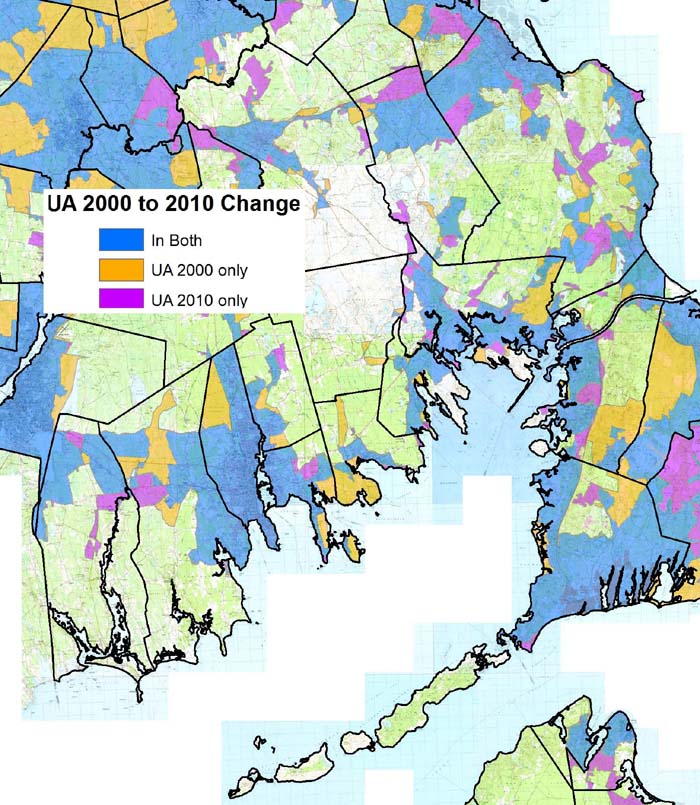
Buzzards Bay Stormwater Collaborative: MS4 Information

Urbanized Areas (UA) in southeastern Massachusetts as defined in the 2000 and 2010 US Census. In this map, any shaded area is now regulated under MS4. The regulated MS4 area will likely be expanded when the results of the 2020 Census are finalized.
Background on the EPA-DEP Phase II Stormwater Permit Program (MS4)
During the past four decades regulatory changes to the Clean Water Act (CWA) have resulted in requirements addressing stormwater runoff and associated pollutants. Beginning in 1987 reauthorization of the CWA included the addition of section 402(p) directing the Environmental Protection Agency (EPA) to implement a phased approach in addressing stormwater pollutants discharging into federally defined Waters of the United States (WOTUS). This phased approach was established under the National Pollutant Discharge Elimination System (NPDES) program allowing for the discharge of point source pollutants to waters of the United States by obtaining a permit. This authorization began in the early 1990s with implementation of Phase I – point discharges from medium and large municipal separate storm sewer systems (MS4s) that service a population of 100,000 or more. Under this permit, municipal applicants needed to develop municipal stormwater management programs to control pollutants to the maximum extent practicable (MEP) and to effectively prohibit non-stormwater discharges to the municipal system. In addition to stormwater activities, Phase 1 also included certain categories of industrial activity, including construction activity disturbing areas greater than 5 acres.
In 1999, EPA extended the NPDES permitting program to include small MS4s in urbanized areas (Phase II). The Final General Permit from Stormwater Discharges for small MS4s was issued in May 2003 and covers “traditional” (cities and towns) and "non-traditional" (federal and state agencies) MS4 Operators. Under the NPDES program’s 2003 permit, small MS4s were required to obtain a permit if it was within a census designated urbanized area (UA) or has been designated by the permit authority as requiring a permit. The Phase II MS4 regulations require small MS4s to develop a program to address six minimum control measures that include Best Management Practices (BMPs) and measurable goals for each BMP. Phase II also regulated construction activity equal to or greater than one acre in size.
The 2003 permit remained in effect until the authorization of the 2016 permit (effective July 1, 2018), then modified December 2020 (effective January 6, 2021) - General Permits for Stormwater Discharges from Small Municipal Separate Storm Sewer Systems in Massachusetts (as modified). One of the components of the 2016 permit (Section 2.3.6) requires municipalities to strengthen their post-construction stormwater management standards for new and re-development sites by updating their existing ordinances (bylaws, regulations). This regulatory update requires municipalities to properly control the post-construction discharge of stormwater from development sites located within their MS4. In particular, the MS4 permit requires post-construction stormwater management systems be designed to remove 90% of the average annual Total Suspended Solids (TSS) Load and 60% of the average annual Total Phosphorus (TP) load generated from impervious surfaces. For redevelopment, the MS4 permit requires that sites be designed to remove 80% of the average annual TSS Load and 50% of the average annual TP load generated from impervious surfaces. And although the permit does not require nitrogen controls, the recommended reduction is 50% Total Nitrogen (communication with EPA Region 1) as described in New Hampshire’s MS4 permit Section 3.3.6.a.i and referenced in Southeast Watershed Alliance - Model Stormwater Management Standards (2012, modified 2017 ; Final-Draft-NMSC-Model-Stormwater-Regulations.pdf) Element C.1.h (new development) and Element D 4/5 (note typo in document, second 4. should be 5.)
Model Bylaws
Under Section 2.3.6. Stormwater Management in New Development and Redevelopment (Post Construction Stormwater Management) the MS4 permittee is required to develop or modify, as appropriate, an ordinance or other regulatory mechanism within three years of the permit (June 2021). To assist the municipalities that have not adopted the appropriate regulations yet or are in the process of rewriting regulations to better fit the language of the MS4 permit, the following links may provide some assistance. Please note: Any bylaw or regulation adopted prior to 2021, may not reflect the language of the modified (effective Jan 2021) permit. Also, the templates have both bylaws and regulations, they should be utilized together.
Harwich (MA) Comprehensive Stormwater and Illicit Discharge Regulation 2018
Northern Middlesex Stormwater Collaborative Model Stormwater Bylaw (August 2020) and Model Stormwater Regulations August 2020
Central Massachusetts Regional Stormwater Coalition - Stormwater Management Bylaw/Ordinance Template (2021) and Stormwater Management Rules and Regulations Template
Neponset Stormwater Partnership Model Stormwater Bylaw May 2019 (Updated June 2021) and Model Stormwater Regulations May 2019 (updated June 2021)